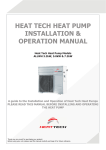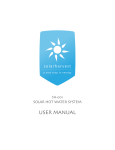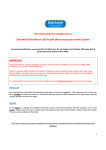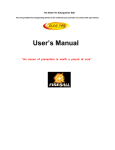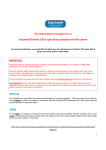Download Brake System Diagnosis and Service Brake System Inspection Road
Transcript
AUMT 1310 - Brake System Diagnosis and Service Automotive Brake Systems 10/5/11 Automotive Brake Systems Brake System Inspection Brake System Diagnosis and Service Donald Jones Brookhaven College • Road test • Hydraulic system • Leaks • Fluid condition • Disc brakes • Rotors and pads • Drum brakes • Drums and linings • Parking brake Automotive Brake Systems Road Test • • • • • • • • • Brake fluid level Brake lamp operation Antilock lamp operation Pedal feel and travel Power assist operation Brake pull Brake vibration Excessive brake noise Parking brake operation Automotive Brake Systems Hydraulic System Inspection • Inspect the brake fluid level and condition • A low brake pedal or red brake lamp could indicate a hydraulic system failure • Check for evidence of external brake fluid leaks Automotive Brake Systems Brake Pedal Reserve • Check for proper pedal operation • The pedal should feel firm not spongy • Low pedal could indicate a leak or improper brake adjustment • Some vehicles have specific brake pedal free height and travel specifications Automotive Brake Systems Brake Lines • Never attempt to repair a damaged brake line • Brake lines are made from steel tubing • Double flare • ISO flare • Allow 1/8” of additional length for each flare • Always use line wrenches when working with brake line fittings 1 AUMT 1310 - Brake System Diagnosis and Service Automotive Brake Systems Brake Hoses 10/5/11 Automotive Brake Systems Common Brake Service Tools • Brake hoses are designed to handle the high hydraulic pressures of braking • Never attempt to repair a brake hose • Always use line wrenches when working with brake hose fittings • Be certain not to twist the hose during installation • Do not reuse the copper washers • Caliper socket set • Brake shoe hold down spring tool • Return spring tool • Bleeder wrenches Automotive Brake Systems Automotive Brake Systems • Metric vs. Standard • Caliper piston compression tool Disc Brakes Inspection Brake Rotor Inspection • Inspect caliper assemblies for leakage • Check pads for contamination and wear • Check rotors for excessive run out and excessive parallelism variance • Brake rotors should be checked for: Automotive Brake Systems Automotive Brake Systems Replacing Brake Pads • Remove excessive brake fluid • Remove and inspect the caliper assembly • Service the rotor as required • Retract the piston • Install new pads • Check and lubricate caliper mounting pins • • • • Lateral run out Parallelism Excessive scoring Hot spots or heat checking • Minimum thickness Caliper Service • Calipers should be serviced if leakage is present or the piston is binding • Overhaul kits include the piston seal and dust boot • The caliper’s bore may be cleaned with crocus cloth or a hone • Components should be cleaned with alcohol • Components may be lubricated with brake fluid or brake assembly lube 2 AUMT 1310 - Brake System Diagnosis and Service Automotive Brake Systems Servicing Wheel Bearings 10/5/11 Automotive Brake Systems Drum Brake Inspection • Remove the dust cap, cotter pin, nut, rotor, bearings and grease seal • Clean and inspect the bearings and races • Pack the bearings with a long soap fiber grease • Reassemble and adjust the bearings as per manufacturer specifications • Inspect the wheel cylinder • Inspect linings for wear and contamination • Inspect springs and hardware • Inspect and measure brake drum Automotive Brake Systems Automotive Brake Systems Brake Drum Inspection • Brake drums should be checked for: • • • • • • • Excessive wear Scoring Barrel shaped Out of round Bell mouthed wear Tapered wear Hot spots or cracking Automotive Brake Systems Wheel Cylinder Service • Wheel cylinders should be serviced if leakage is present • Check for frozen bleeder screws before attempting service • Overhaul kits include the cup seals and dust boots • Check the service manual for information on honing • Components should be cleaned with alcohol • Components may be lubricated with brake fluid or brake assembly lube Servicing Drum Brakes • Clean and inspect all installation hardware • Replace contaminated linings or excessively worn linings • Lubricate the backing plate, anchor posts and self adjuster as appropriate during assembly • Pre-adjust the shoes Automotive Brake Systems Machining Drums and Rotors • Brake lathes are used to restore original surface finish and tolerances • Drums and rotors are mounted on the brake lathe with bearing race or hub flange adapters • Follow equipment the manufacturer’s instructions • Always use the appropriate anti-chatter belt or pad 3 AUMT 1310 - Brake System Diagnosis and Service Automotive Brake Systems Brake Machining Practices • Remove the least amount of metal possible to achieve the proper finish • Never turn the drum or rotor on one side of the vehicle without turning the other side • Rotors should be within 0.002 inch to 0.003 inch side to side • Drum diameters should be within 0.005 inch of each other Automotive Brake Systems Bleeding Brakes • Brakes are bled to remove air and contaminated brake fluid • Manual bleeding • Pressure bleeding • Vacuum bleeding • Brake systems must be bled in the proper order • Always use six point sockets or wrenches on bleeder screws Automotive Brake Systems Parking Brake Adjustment • Parking brake operation should be checked after any brake service is performed • Parking brakes are commonly adjusted at at one of two places • The parking brake pedal or handle • Under the car 10/5/11 Automotive Brake Systems On Car Brake Lathe • Allows rotor machining on the vehicle spindle center line which is the axis of rotation for the rotor • Eliminates the stack-up tolerance of related parts from affecting rotor lateral run out • Bench units machine rotors to the center line of the lathe’s spindle Automotive Brake Systems Bleeding and Flushing Brakes • The brake’s hydraulic system should be flushed and bled anytime major brake work is performed or contamination is suspected • Brake fluid can be checked for moisture galvanic reaction with a DVOM • Hook a voltmeter between the brake fluid and a brake line • Voltage should not exceed 0.3 volts Automotive Brake Systems Air Entrapment Test • Pump the brakes rapidly 20 times and hold the brake pedal depressed • Observe the fluid reservoir when the pedal is released • A geyser or squirt in either reservoir indicates air is trapped in the system 4 AUMT 1310 - Brake System Diagnosis and Service Automotive Brake Systems Automotive Brake Systems Master Cylinder By-Pass Test • Press the brake pedal all the way down one stroke • If the fluid rises as the pedal is depressed and falls when the pedal is released the master cylinder is leaking internally • As a further check hold the brake pedal down firmly for two minutes • If the brake pedal continues to move down over time it may also indicate an internal master cylinder leak Automotive Brake Systems Power Brake Function Test • With the engine off pump the brake pedal several times to exhaust vacuum • Depress the brake pedal with approximately 15 pounds of force • Start the engine • The brake pedal should move down Automotive Brake Systems Brake Pull • • • • • • 10/5/11 Check tire pressure Inspect steering and suspension system Inspect the brake pads Inspect rotors Check for seized calipers Check for equal hydraulic pressure at front calipers • Check wheel bearing preload Compensator Port Test • A small squirt geyser should appear in both reservoirs while depressing the brake pedal • If no geysers are present the master cylinder cup seals may be covering the compensating ports • This may cause the brakes to lock up Automotive Brake Systems Brake Pedal Pulsation • Check for damaged wheel bearings • Check for proper tire balance and tread wear • Inspect the rotors/drums for cracks, scoring and heat checks • Inspect for damaged/contaminated brake pads/shoes • Inspect the caliper slides or pins for corrosion and/or poor lubrication • Check for rotor runout and rotor parallelism • Check for drum concentricity • Turn the rotors/drums if necessary Automotive Brake Systems Brake Light Stays On • Make sure that the parking brake is fully released • Check the fluid level in the master cylinder reservoir • Check for external leaks • Check for internal master cylinder leaks • Check for a shorted brake warning indicator circuit or a faulty switch 5 AUMT 1310 - Brake System Diagnosis and Service Automotive Brake Systems Poor Brake Pedal Return • Check the brake pedal bushings and linkage • Unbolt the master cylinder from the brake booster, depress the brake pedal and release it • If the brake pedal does not return to its original position, replace the power booster • If the brake pedal now returns to its original position, replace the master cylinder Automotive Brake Systems Brakes Locking Up 10/5/11 Automotive Brake Systems Low or Spongy Brake Pedal • Low brake fluid level • External brake system leaks • Internal master cylinder failure • Air in the hydraulic system • Improperly adjusted rear drum brakes Automotive Brake Systems Excessive Pedal Effort • Contaminated brake linings • Defective proportioning valve • Compensating ports not uncovered with brake pedal fully released • Inspect for binding and wear at the brake pedal bushing Automotive Brake Systems Automotive Brake Systems Brakes Drag • Drum brakes • Improperly adjusted brakes • Sticking wheel cylinders • Damaged of improperly installed springs or hardware • Improperly adjusted parking brake • Disc brakes • Sticking caliper • Binding caliper pins or slides • Misadjusted paring brake • Power booster push rod alignment and adjustment • Check brake booster operation • Check for proper vacuum signal to booster • Insect vacuum brake booster check valve for proper operation • Check brake pressure control valve for contamination Brake Noise • Brake noise is more noticeable when the brakes are cold, but some noise may be heard anytime while braking • Semi metallic brake linings extend brake pad life but are may exhibit additional noise during braking • Abnormal brake noise may be caused by: • Excessively worn brake linings • Substandard brake linings • Improper rotor finish • Improper drum brake hardware installation 6






